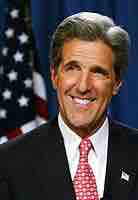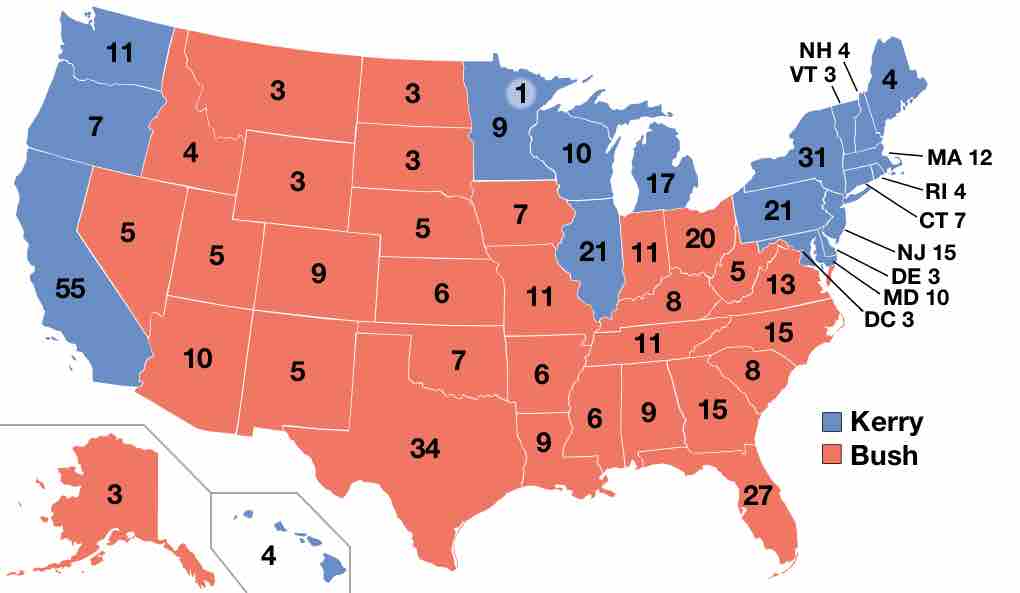Overview
The United States presidential election of 2004 was held on Tuesday, November 2, 2004. Republican Party candidate and incumbent President George W. Bush defeated Democratic Party candidate John Kerry, the then-junior Senator from Massachusetts. Foreign policy was the dominant theme throughout the election campaign, particularly related to Bush's conduct of the War on Terrorism and the 2003 invasion of Iraq. In the Electoral College, Bush received 286 votes to Kerry's 251. Kerry's running mate, John Edwards, who had also run as a Democratic primary candidate, received one electoral vote for president from an elector from Minnesota. This was presumably in error, as that elector also separately voted for Edwards for vice president. Bush's vote total was the highest in history until broken by his successor Barack Obama in 2008.

John Kerry
2004 Democratic Presidential Candidate, John Kerry.
The Campaign
In the wake of the 9/11 attacks, Americans had rallied around their president in a gesture of patriotic loyalty, giving Bush approval ratings of 90%. Even following the first few months of the Iraq war, his approval rating remained historically high at approximately 70%. But as the 2004 election approached, opposition to the war in Iraq began to grow. While Bush could boast of a number of achievements at home and abroad during his first term, the narrow victory he achieved in 2000 augured poorly for his chances for reelection in 2004 and a successful second term.
As the 2004 campaign gained momentum, the president was persistently dogged by rising criticism of the violence of the Iraq war and the fact that his administration’s claims of weapons of mass destruction had been greatly overstated. In the end, no such weapons were ever found. These criticisms were amplified by growing international concern over the treatment of prisoners at the Guantanamo Bay detention camp and widespread disgust over the torture conducted by U.S. troops at the prison in Abu Ghraib, Iraq, which surfaced only months before the election.
With two hot wars overseas, one of which appeared to be spiraling out of control, the Democrats nominated a decorated Vietnam War veteran, Massachusetts senator John Kerry, to challenge Bush for the presidency. As someone with combat experience, three Purple Hearts, and a foreign policy background, Kerry seemed like the right challenger in a time of war. On July 6, 2004, John Kerry selected John Edwards as his running mate, shortly before the 2004 Democratic National Convention in Boston held later that month. Heading into the convention, the Kerry/Edwards ticket unveiled their new slogan—a promise to make America "stronger at home and more respected in the world." This advanced the suggestion that Kerry would pay more attention to domestic concerns; it also encapsulated Kerry's contention that Bush had alienated American allies by his foreign policy.
Kerry's record of support for the invasion of Iraq, however, made his criticism of the incumbent less compelling and earned him the byname “Waffler” from Republicans. The Bush campaign also sought to characterize Kerry as an elitist out of touch with regular Americans—Kerry had studied overseas, spoke fluent French, and married a wealthy foreign-born heiress. Republican supporters also unleashed an attack on Kerry’s Vietnam War record, falsely claiming he had lied about his experience and fraudulently received his medals. Kerry’s reluctance to embrace his past leadership of Vietnam Veterans Against the War weakened the enthusiasm of antiwar Americans while opening him up to criticisms from veterans groups. This combination compromised the impact of his challenge to the incumbent in a time of war.
Bush focused his campaign on national security, presenting himself as a decisive leader and contrasting Kerry as a "flip-flopper." On October 29, four days before the election, excerpts of a video of Osama bin Laden addressing the American people were broadcast on al Jazeera. In his remarks, bin Laden claimed credit for the September 11, 2001 attacks and taunted Bush over his response to them. In the days following the video's release, Bush's lead over Kerry increased by several points.
Results of the Election
Urged by the Republican Party to “stay the course” with Bush, voters listened. Bush won another narrow victory, receiving 62,040,610 popular votes (50.73%) compared to Kerry's 59,028,444 (48.27%). High voter turnout in addition to the nation's growing population meant that both Bush and Kerry received more votes than any presidential candidate in American history. In the six presidential elections from 1992 to 2012, this was the only one in which the Republican candidate won the popular vote. The Republican Party did well overall, picking up four seats in the Senate and increasing its majority there to fifty-five. In the House, the Republican Party gained three seats, adding to its majority there as well. Across the nation, most governorships also went to Republicans, and Republicans dominated many state legislatures.

2004 Presidential Electoral College
Presidential election results map. Red denotes states won by Bush/Cheney, Blue denotes those won by Kerry/Edwards. The split vote in Minnesota denotes an elector's vote counted for Vice President nominee John Edwards. Each number represents the electoral votes a state gave to one candidate.